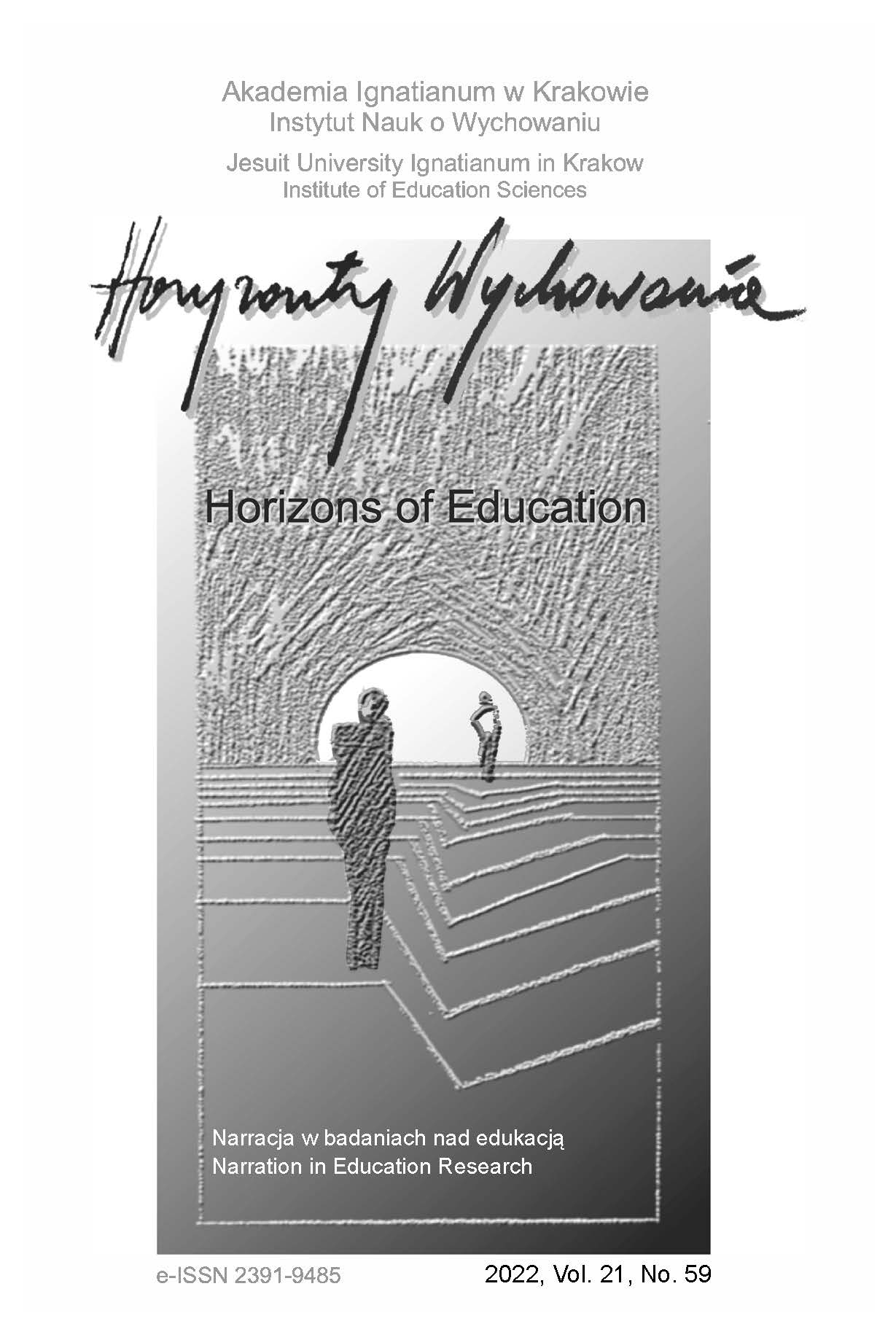Histrionical Blurriness. A God Image Without Features
Abstrakt
CEL NAUKOWY: Eksploracja specyfiki Obrazu Boga w histrionicznej organizacji osobowości.
PROBLEM I METODY BADAWCZE: Główne pytanie badawcze brzmi: czy Obraz Boga w histrionicznej organizacji osobowości jest podobny, czy różni się od obrazu Boga w osobowości z pogranicza? Przeprowadzono strategię metodologiczną Jakościowej Analizy Wtórnej z wykorzystaniem CAQDAS materiału zebranego w projekcie dotyczącym obrazu Boga w organizacji osobowości borderline (Krzysztof-Świderska, 2017).
PROCES WYWODU: Argumentowano wpływ przededypalnych korzeni histrionicznej organizacji osobowości na kształtowanie się swoistego obrazu Boga.
WYNIKI ANALIZY NAUKOWEJ: Wyniki rzucają światło na pewne cechy histrionicznego obrazu Boga: idealizację i nieostrość. Odkryte cechy obrazu Boga u pacjentów histrionicznych korespondują z teoretycznym podejściem Bollasa.
WNIOSKI, INNOWACJE I REKOMENDACJE: Z metodologicznego punktu widzenia w przyszłych badaniach zaleca się standaryzację grup pod kątem fazy terapii. Wskazuje się również, że odgrywanie doświadczanych problemów w przestrzeni religijnej może być potencjalnie niebezpieczne dla tych pacjentów.
Bibliografia
APA. (1980). Diagnostic and statistical manual of mental disorders (3rd ed.). American Psychiatric Association.
APA. (2013). Diagnostic and Statistical Manual of Mental Disorders. American Psychiatric Association. https://doi.org/10.1176/APPI.BOOKS.9780890425596
Anczyk, A., Grzymała-Moszczyńska, H., Krzysztof-Świderska, A., & Prusak, J. (2019). The replication crisis and qualitative research in the psychology of religion. International Journal for the Psychology of Religion, 29(4), 278-291. https://doi.org/10.1080/10508619.2019.1687197
Barker, E. (2013, August). New religious movements: their incidence and significance. LSE Research Online. http://eprints.lse.ac.uk/11887/1/libfile_REPOSITORY_Content_Barker,%20E_New%20religious%20movements
Blagov, P.S., & Westen, D. (2008). Questioning the coherence of histrionic personality disorder: Borderline and hysterical personality subtypes in adults and adolescents. Journal of Nervous and Mental Disease, 196(11), 785-797. https://doi.org/10.1097/NMD.0b013e31818b502d
Bleger, J., Churcher, J., & Bleger, L. (2013). Symbiosis and ambiguity: a psychoanalytic study. Routledge.
Bollas, C. (2000). Hysteria. Routledge.
Caligor, E., Kernberg, O.F., Clarkin, J.F., & Yeomans, F.E. (2018). Psychodynamic therapy for personality pathology : treating self and interpersonal functioning. American Psychiatric Association.
Colman, A.M. (2014). A dictionary of psychology (3rd ed.). Oxford University Press.
Creswell, J.W. (2009). Research design: Qualitative, quantitative, and mixed methods approaches (3rd ed.). SAGE Publications.
Crowe, S., Cresswell, K., Robertson, A., Huby, G., Avery, A., & Sheikh, A. (2011). The case study approach. BMC Medical Research Methodology, 11(100), 1-9. https://doi.org/https://doi. org/10.1186/1471-2288-11-100
De Weger, S.E. (2016). Clerical sexual misconduct involving adults within the roman catholic church. Queensland University of Technology.
Diguer, L., Hébert, É., Gamache, D., Laverdière, O., Daoust, J.-P., & Pelletier, S. (2006). Personality Organization Diagnostic Form. Manual for scoring. Université Laval.
Goldstein, E.G. (1990). Borderline disorders: clinical models and techniques. Guilford Press. https:// www.guilford.com/books/Borderline-Disorders/Eda-Goldstein/9780898624427
Hébert, É., Diguer, L., Descôteaux, J., Daoust, J.P., Rousseau, J.P., Normandin, L., & Scul- lion, M. (2003). The personality organization diagnostic form (podf): A preliminary report on its validity and interrater reliability. Psychotherapy Research, 13(2), 243-254. https://doi. org/10.1080/713869643
Hughes, K., & Tarrant, A. (2020). Qualitative secondary analysis. SAGE Publications.
Klein, M. (1952). The origins of transference. International Journal of Psycho-Analysis, 33, 433-438.
Kohon, G., & Forrester, J. (1999). No lost certainties to be recovered. Routledge. https://doi.org/10.4324/9780429477584
Krzysztof-Świderska, A. (2017). Bóg z pogranicza. Akademia Ignatianum, Wydawnictwo WAM.
Leeming, D.A., Madden, K., & Marlan, S. (2010). Encyclopedia of psychology and religion. https:// doi.org/10.1007/978-0-387-71802-6
Lewis, J.R. (2011). Violence and new religious movements. Oxford University Press.
Madva, E.N., Ross, D.A., & Cooper, J.J. (2019). What’s all the hysteria about? A modern perspective on functional neurological disorders. Biological Psychiatry, 85(2), e3. https://doi.org/10.1016/J. BIOPSYCH.2018.11.003
McWilliams, N. (2011). Psychoanalytic diagnosis understanding personality structure in the clinical process (2nd ed.). Guilford Press.
Novais, F., Araújo, A., & Godinho, P. (2015). Historical roots of histrionic personality disorder. Frontiers in Psychology, 6, 1463. https://doi.org/10.3389/FPSYG.2015.01463/BIBTEX
Pietkiewicz, I., & Smith, J.A. (2012). Praktyczny przewodnik interpretacyjnej analizy fenomenologicznej Praktyczny przewodnik interpretacyjnej analizy fenomenologicznej w badaniach jakościowych w psychologii 1. Czasopismo Psychologiczne, 18(2), 361-369.
Rienzi, B.M., & Scrams, D.J. (1991). Gender stereotypes for paranoid, antisocial, compulsive, dependent, and histrionic personality disorders. Psychological Reports, 69(3 Pt 1), 976-978. https://doi.org/10.2466/PR0.1991.69.3.976
Rizzuto, A.-M. (1979). The birth of the living God: a psychoanalytic study. University of Chicago Press.
Schaap-Jonker, H., Eurelings-Bontekoe, E., Verhagen, P.J., & Zock, H. (2002). Image of God and personality pathology: An exploratory study among psychiatric patients. Mental Health, Religion & Culture, 5(1), 55-71. https://doi.org/https://doi.org/10.1080/13674670110112712
Shapiro, E.R. (1978). The psychodynamics and developmental psychology of the borderline patient: A review of the literature. American Journal of Psychiatry, 135(11), 1305-1315.
Smith, S.F., & Lilienfeld, S.O. (2021). Histrionic personality disorder. In V.S. Ramachandran (ed.), Encyclopedia od Human Behavior (2nd ed., pp. 312-315). Elsevier Inc. https://doi.org/10.1016/ B978-0-12-809324-5.06447-6
Tate, J.A., & Happ, M.B. (2018). Qualitative secondary analysis: A case exemplar. Journal of Pe- diatric Health Care, 32(3), 308-312. https://doi.org/10.1016/J.PEDHC.2017.09.007
Teddlie, C., & Yu, F. (2017). Mixed methods sampling: A typology with examples. Journal of Mixed Methods Research, 1(1), 77-100. https://doi.org/https://doi.org/10.1177/1558689806292430
Wilkinson-Ryan, T., & Westen, D. (2000). Identity disturbance in borderline personality disorder: An empirical investigation. American Journal of Psychiatry, 157(4), 528-541. https://doi.org/10.1176/ APPI.AJP.157.4.528
Winnicott, D.W. (1953). Transitional objects and transitional phenomena; a study of the first not-me possession. The International Journal of Psychoanalysis, 34, 89-97.
Zamawe, F.C. (2015). The implication of using NVivo software in qualitative data analysis: Evidence-based reflections. Malawi Medical Journal, 27(1), 13-15.
Copyright (c) 2022 Horyzonty Wychowania

Utwór dostępny jest na licencji Creative Commons Uznanie autorstwa – Bez utworów zależnych 4.0 Międzynarodowe.
Uwagi dotyczące praw autorskich
Autorzy publikujący w tym czasopiśmie wyrażają zgodę na następując warunki:
- Autorzy zachowują prawa autorskie, przyznając czasopismu prawo do pierwszej publikacji swojego tekstu jednocześnie zarejestrowanego pod numerem licencji CC BY-ND, która pozwala innym na korzystanie z tego tekstu z uznaniem autorstwa tekstu oraz pierwotnej publikacji w tym czasopiśmie.
- Autorzy proszeni są o nawiązywanie odrębnych, dodatkowych porozumień wynikających z umowy, dotyczących dystrybucji opublikowanej w czasopiśmie wersji tekstu nie na prawach wyłączności (np. opublikowanie go w repozytorium instytucji lub w innym czasopiśmie), z potwierdzeniem pierwszej publikacji w tym czasopiśmie.
Wyraża się zgodę i zachęca autorów do publikacji ich tekstu w Internecie (np. w repozytorium instytucji lub na jej stronie internetowej) przed lub podczas procesu składania tekstu jako, że może to prowadzić do korzystnych wymian oraz wcześniejszego i większego cytowania opublikowanego tekstu (Patrz The Effect of Open Access). Zalecamy wykorzystanie dowolnego portalu stowarzyszeń badawczych z niżej wymienionych:





